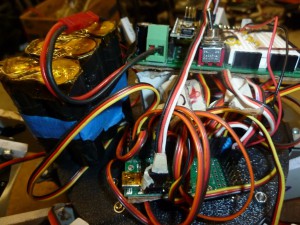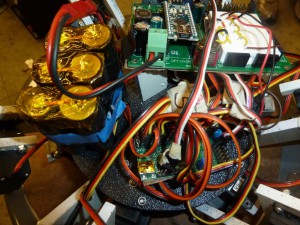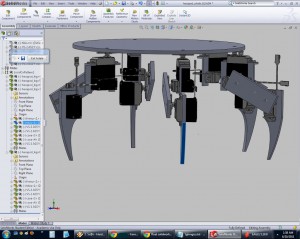Note to self: shortcuts: < > ctrl-= alt-w
Meanwhile, I think an instructable a week sounds like an excellent plan for Spring semester senior year.
Note to self: shortcuts: < > ctrl-= alt-w
Meanwhile, I think an instructable a week sounds like an excellent plan for Spring semester senior year.
EDIT 4 Dec 2012:
As of august 2012-ish (I haven’t tried to run hexapod since then, because I ate my pololu controller sometime while dragging my hexapod all around the country this summer >__< Ugh I fail at taking care of expensive electronic things), there are some syntax changes if you’re using the latest version of arduino because newsoftserial is now built into arduino, not a separate library.
This version of the code is also slightly better organized…
https://github.com/nouyang/18-servo-hexapod/blob/master/pololu_aug17-2012.pde
[updated because i saw a link from http://forum.pololu.com/viewtopic.php?f=16&t=6188&p=29520#p29520]
EDIT 18 March 2013:
I made a video about my hexapod.
[updated because I saw a link from hexy forums]
 |
| Fig. 1 |
My current setup: eighteen servos on maestro pins 1-18 (pin 0 left empty), VSRV=VIN jumper has been removed. 8.4V battery pack fed through 5V linear regulator on carrier board. The servo wire with with masking tape comes from PIN2 of the carrier board/arduino setup and is supplying the pololu controller with GND, VIN, and the serial signal. Red and black wires going from breadboard on carrier board to VSRV on maestro.
If all that didn’t make sense…
Steps
#include <NewSoftSerial.h>
#define txPin 2
NewSoftSerial mySerial(rxPin, txPin);
void setup(){
mySerial.begin(9600);
delay(1000);
}
we should take a servo female-female wire, put one end on servo male header pins for pin 2 of Arduino.

Why remove the jumper? Well, a. Makes the pololu RX pin happier (compare to setup below) b. Setting that jumper seems to current-limit the power going to the servos, leading to my sad-servo symptoms. aka unable-to-walk hexapod.
 |
| the single pin (pololu RX) inside the masking-tape-servo-cable is a sad pin. The cable also falls off often. |
I used the jumper originally because I was thinking I would need two batteries (one for VSRV one for VIN) or something otherwise. But hey look, it’s setup to be neater without the jumper, I’m still only dealing with one battery, and my hexapod doesn’t work with the jumper on. u___u
b. Software
[edit 27 Jun 2011 I fixed the many errors in my post, as pointed out on the pololu forums: Pololu maestro and arduino again]
1) newsoftserial should be downloaded from the internet and the folder inside the zip put in (path to where you unzipped arduino)/arduino/libraries/ (e.g. for ubuntu 10.10 via the repository, /usr/share/arduino/libraries)
And the code from http://www.pololu.com/docs/0J40/5.e or from above means:
a. BYTE is a parameter that pecifies the base (format) to us http://www.arduino.cc/en/Serial/Print
b. target is a non-negative integer less than 8192 (it can be written in binary notation with 14 or fewer digits)
e.g. 6000, or in binary: 01011101110000
c. 0x7F is 01111111 in binary, which infinity zeros to the left, so “&”ing (bitwise AND) it masks out all the digits in target (when target is written in binary) except the last 7 digits (only 1 AND 1 == 1. all other combinations == 0)
01011101110000
& 00000001111111
= 00000001110000
d. right shift operator, shifts last seven digits (numbers 7 through 13) in target off into empty space and so now the “new” last seven digits were originally bits #0 to 6 (see color-coded pololu doc). Mask with 0x7F again, just to be sure.
01011101110000,>>7 to:
00000000101110, then:
& 00000001111111
= 00000000101110You can see the code I used with Fig. 1 here: https://github.com/nouyang/18-servo-hexapod/blob/036271da7e66b80ff7ea732ea13b7028b43d28ac/pololu_jun17a.pde
The main difference from the default code is that I mapped the values so that I could mindlessly port code from arduino-“Servo.write()”-style to pololu-“settarget()”-style.
void settarget(unsigned char servo, unsigned int target)
{
target = map(target, 0, 180, 2400, 9500);
Also feel free to compare to original arduino version: https://github.com/nouyang/18-servo-hexapod/blob/master/arduino_may13_2011.pde
Great success! I learned CAD. Or rather Amy worked through the point I kept getting stuck on (a particular series of mates for the hexapod leg assembly), and then it was fairly easy sailing from there. Yay 🙂
 |
| not sure why it has 5 legs, might’ve hidden one when I screenshot’d |
In other news, I didn’t make much headway on the pololu issue where something about my setup using Arduino + Pololu Mini Maestro is off (Dane showed me how to check with the multimeter to verify that the voltage was dropping to zero, aka symptoms of current limiting). I even took twenty minutes to wire everything to the original Arduino Nano (+ 2.007 carrier board) state, and verified that it did sound much… happier (yay the sound of 18 bloodthirsty happy servos =]). But I did read up more on serial and code, which was fun and hurt my head.